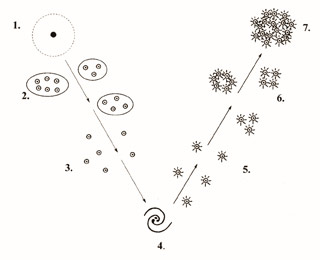 Home
News
Vision
The 7 Phases
Books
Articles
Related articles
The counterforces
About Margarete
Quotes / Test
Links / Contact
Home
News
Vision
The 7 Phases
Books
Articles
Related articles
The counterforces
About Margarete
Quotes / Test
Links / Contact
|
Stages of the human evolution
Human evolution does not proceed by accident, randomly or just by itself, spontaneously. When you look carefully you see that this is not the case. As humans we are in continuous process of development: again and again we take new steps. In each of these new steps or phases, a certain element, a capacity, or a certain quality, comes to the fore and develops. In this process one phase flows as it were naturally from the preceeding one and so the two link up and connect. The stages thus together constitute a path. A path that leads from a certain starting point to a new situation. Along this path development takes place – a development of capacities and consciousness. Thanks to the ancient wisdom of the esoteric tradition I have learned to recognize and distinguish these stages or phases that underlie our human development. Once you know their characteristics, you can recognize them everywhere in life, on all kinds of levels. What are these stages? In order to capture their characteristics in an image I have developed the Phase Model. This model shows schematically the successive stages of development which each human being on this earth is involved in. The Phase Model forms the basis of my book 'Transforming People and Organizations. The Seven Steps of Spiritual Development'.
The Phase Model shows that the human development on earth runs
The old world, the new world, and the phasic developmentIn the scheme of the seven phases we can distinguish phases that belong to the old world, phases that are part of the new world, and a phase that is characteristic of the transition between the two.
In the transitional phase 4, the old path of development comes to and end and loses its power. At the same time, an inward process of transformation takes place. In this the 'old'- that which no longer serves the developmental process – is let go and a connection is established with the new forces and inspirations of the inner spirit: the conscious center within one's own soul. The new world thus begins in phase 4. As the symbol for phase 4 shows, the old world does not simply transit into the new world. Between the two there is a gap: a situation in which the old no longer exists and the inner link with the new is still insufficiently strong. This is the period of transition that, with its chaos and confusion, is a time of crisis. In the section 'The phase model on different levels' I tell more about the various areas or levels where the development in phases can be recognized.
|









